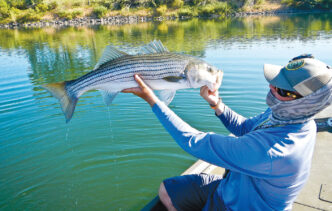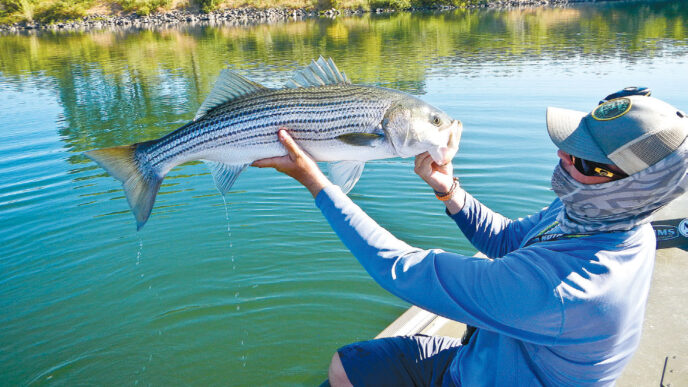Flank steak is the leanest and healthiest cut of beef, with low fat, cholesterol, and calories per ounce, and it lends itself very well to outdoor and camp cooking. Few meats grill as well under a variety of cooking-fire conditions, developing a tasty, caramelized crust that satisfies the carnivore cravings of digestive systems evolved from our meat-eating ancestors. An added benefit is that these relatively thin steaks, characterized by longitudinal muscle fibers and by a lack of fat, are wonderful used as leftovers. Whether sliced as thinly as possible for sandwiches or when used in beef tacos, Asian stir fries, or in a one-dish salad of beef, greens, fruit, and noodles, they stand on their own.
In the 1950s, an Italian friend of my parents introduced us to this inexpensive cut of beef, which then was rarely found at supermarket meat counters. The son of an immigrant fisherman, he grew up in San Francisco’s North Beach district. His mother bought flank steak from Italian butchers, because at that time, it was considered a cheap cut. She used it for the classic Sunday braciole, with the flat cut butterflied or pounded thin and stuffed with ricotta cheese and spinach or chard and perhaps pine nuts, then rolled and tied with four or five strings. Next came searing, often in lard, to develop a crust, then slow braising in tomato sauce, sometimes with a bit of added vino rosa and always with lots of garlic and herbs. The dish transcends regionalism in Italy, and there are many variations.
Flank steaks at Costco or your favorite butcher typically weigh from one and a half to two and a half pounds and come two or three to the package. Individually, they range from 12 to 18 inches long, tapering on both ends, but more so on one end than on the other. Fat marbling is absent, and there is no fatty rind that can render and flare up on the grill. I buy the multisteak packages at Costco, usually cooking one that evening or the next day and individually wrapping and freezing the other. They thaw quickly when you need something that is tasty and easy and fast to prepare.
Whenever possible, I marinate this cut of meat to develop flavor and tenderize it. At home, I throw a thawed steak directly into my vacuum marinator. The manufacturer claims it does the job in as little as 20 minutes after you pull the vacuum with a hand pump. It works, but longer is better. Another simple method uses a gallon Ziploc bag. I like this in camp, because it eliminates another prep vessel. Turn it several times during the marinating period to get even penetration. Overnight is good, and I often start this process the day before I plan to cook in camp. Don’t overdo it much beyond a full 24 hours, though. Marinades contain acids. Although they tenderize, they can make meat mushy if they are too strong or go on too long. A favorite that doesn’t require any prep time (important in any cooking) is a proprietary product called Basque Meat Tenderizer that I’ve mentioned before. It’s a red vinegar, garlic, and herb mixture that I can’t match on my own. Acid marinades are good, because bacteria multiply very slowly in an acid environment . . . important for food safety, but you should still keep your meat refrigerated. I amp up the steak by dusting it with garlic granules after I have wiped excess marinade off the meat. Remember that meat grills best when brought to room temperature before it goes on the grill.
Another easy and tasty marinade is a light soy-garlic mixture, because soy sauce is a natural tenderizer. Don’t forget that some individuals are sensitive or allergic to soy. Use crystallized garlic granules, rather than garlic salt. The soy sauce has enough sodium. An even better option is to use fresh minced garlic.
Sometimes I need a slight mustard taste to satiate my food cravings. I mix generous amounts of Grey Poupon or other Dijon-style mustard with a dry white wine and fresh minced garlic or garlic granules for a marinade. If I want a little more of a salty flavor, I add some light soy. Slather the steak on both sides before putting it in that marinade Ziploc. After grilling, there’s just a hint of mustard flavor in the wonderful caramelized crust.
I grill on medium to medium-high heat, whether on a campfire, gas grill, or over charcoal. You want to sear and cook quickly. Flank steak takes 8 to 9 minutes for a small, thin one and 13 to 14 minutes for a two-and-a-half-pounder, depending on outside temperature and humidity. The thinness of the steak gives inaccurate meat thermometer readings, but shoot for around 120 degrees Fahrenheit. I admit to using my pocketknife and a flashlight on occasion to test for doneness. The touch test that works for thicker cuts doesn’t work as well for flank steak. (See “Better Steaks at Home and in Camp” in “The Foraging Angler,” California Fly Fisher, January/February 2015.) Remove the steak and cover it loosely with foil for 10 minutes. This resting allows the juices to pull back into the meat, enhancing flavor and tenderness. During this time, the internal temperature will rise another 10 or 12 degrees, and your meat will be a perfect medium-rare. The thinner ends will be a touch more done, and some might like that. Use a sharp knife to slice the slab diagonally across the grain, and cut it as thinly as possible. Don’t dally in plating and getting at it.
Flank steak lends itself well to larger groups. Two, three, or more grill just as easily as one, and the individual portions match appetites. Leftovers hold well in a refrigerator for a number of days and offer easy, delicious menu possibilities. When thinking about leftovers, three dishes immediately come to mind, and they’re simple enough to prepare in camp if you’ve brought the proper ingredients.
The first dish is a thinly sliced flank steak sandwich with roasted green chilies, red onion, arugula, cilantro, Monterey jack cheese, and avocado cream mayonnaise on artisan bread. A favorite bread here in the mountains is Truckee River Sourdough Pugliese, but any high-quality artisan bread brings out the best texture and flavor. This requires a good Argentine Malbec to complement the perfect marriage of crusty medium-rare beef, roasted chilies, sweet red onions, and avocado.
A second easy-to-prepare leftover dish is beef tacos. I slice pieces from my leftover steak and julienne (matchstick) the medallions. A cast iron plancha is perfect for heating your favorite tortillas. One taco version uses Mexican Cotija cheese, iceberg lettuce, green onions, avocado slices, black or pinto beans, diced tomatoes, cilantro, and a favorite pico de gallo. Sometimes we make an Asian version using beef, red and white cabbage, julienned carrots, slivers of red bell pepper, green onions, and cilantro. Cheese isn’t appropriate here, but Thai sweet chili sauce matches well with the ingredients.
Beef and oranges are a luscious culinary combination that works in a one-dish noodle preparation. Start by tossing prewashed baby arugula into a wide, shallow serving bowl. Next comes a layer of chow mein or soba noodles, then more arugula, possibly mixed with baby spinach, and fresh bean sprouts. I follow with sliced, peeled orange segments, mixed with kiwi and pineapple chunks and mango or papaya in season, sometimes recruiting a fellow fisher to help with the prep work. Add a generous layer of julienned leftover flank steak, and finish it with your choice of peanuts, cashews, macadamia nuts, or pistachios and with cilantro sprigs. A fresh raspberry or two on top doesn’t hurt. You will smell the tangy fresh citrus flavors from across camp. Dress it just before serving with your favorite Chinese chicken salad dressing. We like Alder Market Sesame Spinach Dressing. You can make your own version, but it’s a pain to carry all the ingredients in your camp cook kit.
Dig deep with salad forks and spoons to mix the ingredients, but let your tablemates have a look at your creation first. There’s lots of flexibility in ingredients here. Use prewashed ingredients to simplify prep time. I buy my prepackaged noodles in Asian grocery sections. Rarely are microwaves found in camp, unless you are operating out of an RV, but these noodles take very short boiling times. An alternative is to precook the noodles (some already are) and toss for a few minutes in a skillet. A universal cooking implement, the chopstick, works very well here.
Lean flank steak is a medium-priced cut of beef that travels well and allows tasty, satisfying meals with a minimum of cooking time and preparation. Leftovers are added bonuses that simplify meal preparation on the following day without sacrificing quality.
A Handful of Suggestions
From Bruce H. Forsythe, DDS Sebastopol
When fishing the low-flow section of the Feather River at Oroville, I have been pretty frustrated as to places to eat, at least until I found the Pho Noodle House at 1898 Bird Street. They have first-class Vietnamese food at reasonable prices, and even the locals don’t seem to know about it. Across the street from my favorite motel (America’s Best Value) at 491 Oro Dam Boulevard East is the Blueberry Twist Restaurant, which opens early and has good breakfasts at very low prices if you get the early-bird specials. Even the coffee is inexpensive.
When going through Yuba City, Los Charros Taqueria at 425 Colusa Avenue (just before the bridge) is the place to go. My wife, who is Mexican and who turned up her nose at the place when she first saw it, now makes it one of her “go to” stops.
If you are passing through Knights Landing and see a taco truck in an empty lot in the center of town, do yourself a favor and try the tacos there (especially the pastor or the carne asada). It is open every day except when the owner picks his daughter up at school. The tacos are cheap and he makes the best tomatillo sauce.
When traveling along Interstate 5, for muy autentico Mexican food in Williams, take the E Street Exit west into the center of town. Go south at the main intersection one block (past Louis Cairo’s) and turn left on to Home Street. On the south side of the street next to Napa Auto Parts is a Mexican market connected to a little kitchen with a window onto the sidewalk. They have the usual taqueria fare, plus occasional specials that are pretty interesting if you are into taquerias. One of the specials is a shredded beef taco with chipotle salsa. It’s all good, and you can sit in the market (it’s a nice Mexican market) or outside.
Beer in Cans: An Appreciation
By Richard Anderson
This year, 2015, is the 80th birthday of the beer can. It met with great popularity when first introduced — cans stopped sunlight from harming the beverage, they didn’t break when dropped, they were lighter than glass, plus they were easily stackable, storable, and transportable.
And, an important consideration on a hot summer day, they cooled more quickly than bottles when submerged in a trout stream.
Somehow over the years, though, cans fell out of favor, or at least out of favor for high-end brews. (Your inexpensive American “ lawnmower” beer, by contrast, is frequently consumed from cans.) The bias of craft brewers toward bottles is changing, however, reflecting a movement led in part by the 21st Amendment Brewery of San Francisco. Nine of their specialty beers are available in aluminum cans, and some are sold at your neighborhood supermarket. My favorite of theirs is a seasonal, somewhat low-alcohol (4.9 percent ABV) wheat beer named Hell or High Watermelon. The brewery describes it as “surprisingly crisp, dry, and refreshing — summer in a can.” For once, the PR hype is right on.
















